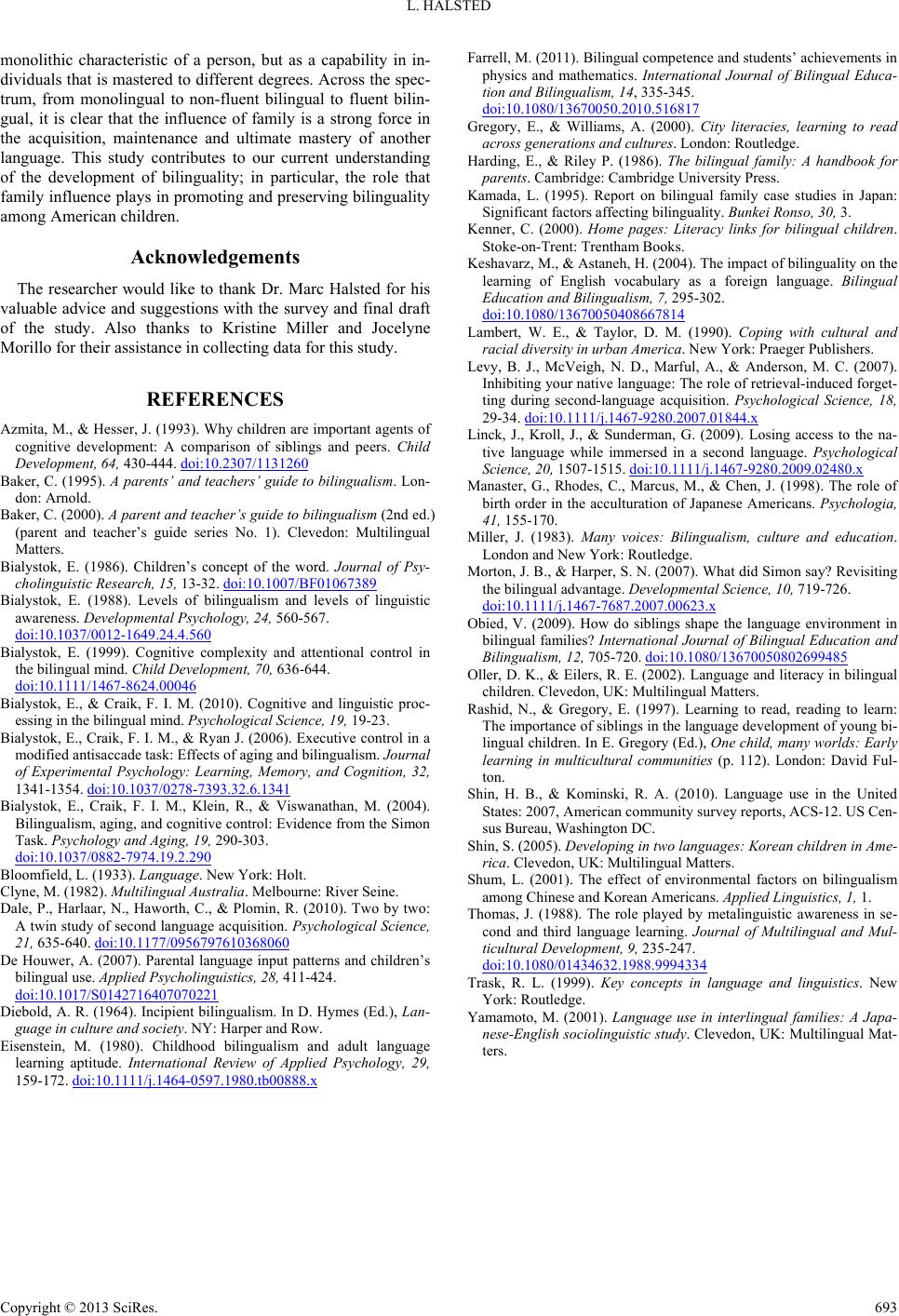
L. HALSTED
Copyright © 2013 SciRes. 693
monolithic characteristic of a person, but as a capability in in-
dividuals that is mastered to different degrees. Across the spec-
trum, from monolingual to non-fluent bilingual to fluent bilin-
gual, it is clear that the influence of family is a strong force in
the acquisition, maintenance and ultimate mastery of another
language. This study contributes to our current understanding
of the development of bilinguality; in particular, the role that
family influence plays in promoting and preserving bilinguality
among American children.
Acknowledgements
The researcher would like to thank Dr. Marc Halsted for his
valuable advice and suggestions with the survey and final draft
of the study. Also thanks to Kristine Miller and Jocelyne
Morillo for their assistance in collecting data for this study.
REFERENCES
Azmita, M., & Hesser, J. (1993). Why children are important agents of
cognitive development: A comparison of siblings and peers. Child
Development, 64, 430-444. doi:10.2307/1131260
Baker, C. (1995). A parents’ and teachers’ guide to bilingualism. Lon-
don: Arnold.
Baker, C. (2000). A parent and teacher’s guide to bilingualism (2nd ed.)
(parent and teacher’s guide series No. 1). Clevedon: Multilingual
Matters.
Bialystok, E. (1986). Children’s concept of the word. Journal of Psy-
cholinguistic Research, 15, 13-32. doi:10.1007/BF01067389
Bialystok, E. (1988). Levels of bilingualism and levels of linguistic
awareness. Developmental Psychology, 24, 560-567.
doi:10.1037/0012-1649.24.4.560
Bialystok, E. (1999). Cognitive complexity and attentional control in
the bilingual mind. Child Development, 70, 636-644.
doi:10.1111/1467-8624.00046
Bialystok, E., & Craik, F. I. M. (2010). Cognitive and linguistic proc-
essing in the bilingual mind. Psychological Science , 19, 19-23.
Bialystok, E., Craik, F. I. M., & Ryan J. (2006). Executive control in a
modified antisaccade task: Effects of aging and bilingualism. Journal
of Experimental Psychology: Learning, Memory, and Cognition, 32,
1341-1354. doi:10.1037/0278-7393.32.6.1341
Bialystok, E., Craik, F. I. M., Klein, R., & Viswanathan, M. (2004).
Bilingualism, aging, and cognitive control: Evidence from the Simon
Task. Psychology and Aging, 19, 290-303.
doi:10.1037/0882-7974.19.2.290
Bloomfield, L. (1933). Language. New York: Holt.
Clyne, M. (1982). Multilingual Australia. Melbourne: River Seine.
Dale, P., Harlaar, N., Haworth, C., & Plomin, R. (2010). Two by two:
A twin study of second language acquisition. Psychological Science,
21, 635-640. doi:10.1177/0956797610368060
De Houwer, A. (2007). Parental language input patterns and children’s
bilingual use. Applied Ps ych oli ngu is tics, 28, 411-424.
doi:10.1017/S0142716407070221
Diebold, A. R. (1964). Incipient bilingualism. In D. Hymes (Ed.), Lan-
guage in culture and society. NY: Harper and Row.
Eisenstein, M. (1980). Childhood bilingualism and adult language
learning aptitude. International Review of Applied Psychology, 29,
159-172. doi:10.1111/j.1464-0597.1980.tb00888.x
Farrell, M. (2011). Bilingual competence and students’ achievements in
physics and mathematics. International Journal of Bilingual Educa-
tion and Bilingualism, 1 4, 335-345.
doi:10.1080/13670050.2010.516817
Gregory, E., & Williams, A. (2000). City literacies, learning to read
across generations and cultur es. London: Routledge.
Harding, E., & Riley P. (1986). The bilingual family: A handbook for
parents. Cambridge: Cambridge University Press.
Kamada, L. (1995). Report on bilingual family case studies in Japan:
Significant factors affecting bilinguality. Bunkei Ronso, 30, 3.
Kenner, C. (2000). Home pages: Literacy links for bilingual children.
Stoke-on-Trent: Trentham Books.
Keshavarz, M., & Astaneh, H. (2004). The impact of bilinguality on the
learning of English vocabulary as a foreign language. Bilingual
Education and Bilingualism, 7, 295-302.
doi:10.1080/13670050408667814
Lambert, W. E., & Taylor, D. M. (1990). Coping with cultural and
racial diversity in urban America. New York: Praeger Publishers.
Levy, B. J., McVeigh, N. D., Marful, A., & Anderson, M. C. (2007).
Inhibiting your native language: The role of retrieval-induced forget-
ting during second-language acquisition. Psychological Science, 18,
29-34. doi:10.1111/j.1467-9280.2007.01844.x
Linck, J., Kroll, J., & Sunderman, G. (2009). Losing access to the na-
tive language while immersed in a second language. Psychological
Science, 20, 1507-1515. doi:10.1111/j.1467-9280.2009.02480.x
Manaster, G., Rhodes, C., Marcus, M., & Chen, J. (1998). The role of
birth order in the acculturation of Japanese Americans. Psychologia,
41, 155-170.
Miller, J. (1983). Many voices: Bilingualism, culture and education.
London and New York: Routledge.
Morton, J. B., & Harper, S. N. (2007). What did Simon say? Revisiting
the bilingual advantage. Developmental Science, 10, 719-726.
doi:10.1111/j.1467-7687.2007.00623.x
Obied, V. (2009). How do siblings shape the language environment in
bilingual families? International Journal of Bilingual Education and
Bilingualism, 12, 705-720. doi:10.1080/13670050802699485
Oller, D. K., & Eilers, R. E. (2002). Language and literacy in bilingual
children. Clevedon, UK: Multilingual Matters.
Rashid, N., & Gregory, E. (1997). Learning to read, reading to learn:
The importance of siblings in the language development of young bi-
lingual children. In E. Gregory (Ed.), One child, many worlds: Early
learning in multicultural communities (p. 112). London: David Ful-
ton.
Shin, H. B., & Kominski, R. A. (2010). Language use in the United
States: 2007, American community survey reports, ACS-12. US Cen-
sus Bureau, Washington DC.
Shin, S. (2005). Developing in two languages: Korean children in Ame-
rica. Clevedon, UK: Multilingual Matters.
Shum, L. (2001). The effect of environmental factors on bilingualism
among Chinese and Korean Americans. Applied Linguistics, 1, 1.
Thomas, J. (1988). The role played by metalinguistic awareness in se-
cond and third language learning. Journal of Multilingual and Mul-
ticultural Development, 9, 235-247.
doi:10.1080/01434632.1988.9994334
Trask, R. L. (1999). Key concepts in language and linguistics. New
York: Routledge.
Yamamoto, M. (2001). Language use in interlingual families: A Japa-
nese-English sociolinguistic study. Clevedon, UK: Multilingual Mat-
ters.